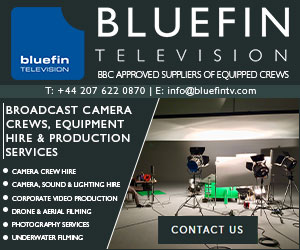Broadcast News
01/04/2014
A Strategy For Testing 4K Video...

The ever-increasing reach of 4K fever means that test and measurement will have to adapt, writes Adam Schadle, Vice President of Video Clarity.
With the onslaught of devices aimed at 4K and beyond, it's inevitable that broadcasters will have to deliver 4K content - reliably and with high quality - in all types of formats. Doing so requires a multifaceted strategy for testing and analysing video quality in order to understand the quality of experience the viewers will receive.
What's Being Tested
In today's typical delivery network, a media operation might receive a program feed from a satellite or an existing network, or an uncompressed file from a postproduction process. From there the operation provides both high-bit-rate encoded video for broadcast and is also outputting 'adaptive streams' as a number of profiles, in different bit rates to support any number of OTT platforms.
Right now those original uncompressed streams are primarily high-definition pictures, but increasingly the content will be in 4K - and it must be decoded on the fly, recorded, ingested for QC testing, and encoded using the compression codecs required by the target devices. During the testing phase, the system must provide an automated means of testing key attributes of video quality, audio quality, lip sync, loudness and ancillary content.
Important Elements Of A Testing Solution
The most important capability in a video-quality testing solution is its ability to ingest, record in 4K resolution and test content from any compressed or uncompressed video source using today's SDI-type interfaces. Another major criterion is the solution's ability to decode any encoded file in the current MPEG or JPEG standards as well as emerging encoding standards such as HEVC.
Finally, the system must be able to play back the content in every resolution required for delivery to every screen, from UHDTV and HDTV to mobile device resolutions.
In addition to those key elements, the right testing tools will support the full range of resolution levels, from streaming formats for handheld devices and PCs, to today's most active broadcast-level HD formats, to high-frame-rate HD, to, of course, 4K.
In addition, the testing solution will have a wide variety of input and output capabilities to enable customers to test individual devices and then place them into a test network architecture — either at a live broadcasting plant, a content delivery network, or in the lab of the product's manufacturer or developer.
Accounting For Audio
Audio quality requires more types of testing than video, so the right testing solution will also perform three key audio measurements:
Perceptual quality testing, which simulates a human perception test and creates a measurement that is as close as possible to an actual subjective study done in a standardised environment.
Real-time performance monitoring to identify performance issues with audio devices or audio in the network chain. These tests find audio faults such as silences and glitches, and the system logs the failure and simultaneously records the offending video in a real-time test session. Audio performance testing also covers lip sync measurements with millisecond accuracy.
Audio loudness testing, which has become extremely important with the adoption of global loudness standards. Effective loudness testing involves applying loudness standards to every individual audio channel and reporting a measurement for a program as a group.
Real-Time vs. Non-Real-Time Testing
Real-time testing measures performance over time of an audio and video signal as it goes through a device or over the air. With real-time testing tools, an operator can monitor a signal according to certain test threshold parameters and then determine its performance over time.
Non-real-time quality testing is a repetitive process that is useful for fine-tuning a device codec design, setting, or network path to achieve a desired level of quality. Typically, it involves recording sets of audio and video content that have certain error-prone characteristics, such as high motion, and then measuring quality repeatedly through network video and audio processing with a certain variable, such as encoding bit rate. In this manner, the operator can reset or revise the variable to determine the optimal setting of a given device for delivery to a given end-user device.
First Things First
Testing and QC must take place not only after the content goes live, but before, with testing tools that can ingest video from any source and then play it back in every resolution for delivery to every screen. Broadcasters and service providers who are planning to launch 4K services are in the preliminary testing stages now, researching the technology requirements of delivering 4K content to a wide range of services: real-time TV channels delivered through cable IPTV or satellite, file-based delivery of VOD content, and streaming content over the Internet. Based on that research, they will define their workflows and assemble the right combination of gear to meet the coming demand for 4K content.
Read the article in the online edition of RFV here.
With the onslaught of devices aimed at 4K and beyond, it's inevitable that broadcasters will have to deliver 4K content - reliably and with high quality - in all types of formats. Doing so requires a multifaceted strategy for testing and analysing video quality in order to understand the quality of experience the viewers will receive.
What's Being Tested
In today's typical delivery network, a media operation might receive a program feed from a satellite or an existing network, or an uncompressed file from a postproduction process. From there the operation provides both high-bit-rate encoded video for broadcast and is also outputting 'adaptive streams' as a number of profiles, in different bit rates to support any number of OTT platforms.
Right now those original uncompressed streams are primarily high-definition pictures, but increasingly the content will be in 4K - and it must be decoded on the fly, recorded, ingested for QC testing, and encoded using the compression codecs required by the target devices. During the testing phase, the system must provide an automated means of testing key attributes of video quality, audio quality, lip sync, loudness and ancillary content.
Important Elements Of A Testing Solution
The most important capability in a video-quality testing solution is its ability to ingest, record in 4K resolution and test content from any compressed or uncompressed video source using today's SDI-type interfaces. Another major criterion is the solution's ability to decode any encoded file in the current MPEG or JPEG standards as well as emerging encoding standards such as HEVC.
Finally, the system must be able to play back the content in every resolution required for delivery to every screen, from UHDTV and HDTV to mobile device resolutions.
In addition to those key elements, the right testing tools will support the full range of resolution levels, from streaming formats for handheld devices and PCs, to today's most active broadcast-level HD formats, to high-frame-rate HD, to, of course, 4K.
In addition, the testing solution will have a wide variety of input and output capabilities to enable customers to test individual devices and then place them into a test network architecture — either at a live broadcasting plant, a content delivery network, or in the lab of the product's manufacturer or developer.
Accounting For Audio
Audio quality requires more types of testing than video, so the right testing solution will also perform three key audio measurements:
Perceptual quality testing, which simulates a human perception test and creates a measurement that is as close as possible to an actual subjective study done in a standardised environment.
Real-time performance monitoring to identify performance issues with audio devices or audio in the network chain. These tests find audio faults such as silences and glitches, and the system logs the failure and simultaneously records the offending video in a real-time test session. Audio performance testing also covers lip sync measurements with millisecond accuracy.
Audio loudness testing, which has become extremely important with the adoption of global loudness standards. Effective loudness testing involves applying loudness standards to every individual audio channel and reporting a measurement for a program as a group.
Real-Time vs. Non-Real-Time Testing
Real-time testing measures performance over time of an audio and video signal as it goes through a device or over the air. With real-time testing tools, an operator can monitor a signal according to certain test threshold parameters and then determine its performance over time.
Non-real-time quality testing is a repetitive process that is useful for fine-tuning a device codec design, setting, or network path to achieve a desired level of quality. Typically, it involves recording sets of audio and video content that have certain error-prone characteristics, such as high motion, and then measuring quality repeatedly through network video and audio processing with a certain variable, such as encoding bit rate. In this manner, the operator can reset or revise the variable to determine the optimal setting of a given device for delivery to a given end-user device.
First Things First
Testing and QC must take place not only after the content goes live, but before, with testing tools that can ingest video from any source and then play it back in every resolution for delivery to every screen. Broadcasters and service providers who are planning to launch 4K services are in the preliminary testing stages now, researching the technology requirements of delivering 4K content to a wide range of services: real-time TV channels delivered through cable IPTV or satellite, file-based delivery of VOD content, and streaming content over the Internet. Based on that research, they will define their workflows and assemble the right combination of gear to meet the coming demand for 4K content.
Read the article in the online edition of RFV here.
Top Related Stories
Click here for the latest broadcast news stories.
11/11/2016
What Is The Future For Immersive Audio?
Peter Poers, Managing Director at Jünger Audio, looks at production efforts versus consumer experience. Introduction Along with the evolution of highe
What Is The Future For Immersive Audio?
Peter Poers, Managing Director at Jünger Audio, looks at production efforts versus consumer experience. Introduction Along with the evolution of highe
29/09/2000
DNA TESTING FOR VIDEO
CONTENTWISE, developers of video matching technology, have launched a new system, RecogVision. The system makes it easier to find matching videos from
DNA TESTING FOR VIDEO
CONTENTWISE, developers of video matching technology, have launched a new system, RecogVision. The system makes it easier to find matching videos from
20/02/2024
NADiV Audio Introduces Range Of Dante Audio And Control Devices
NADiV Audio has launched its NADiV range of Dante-enabled audio interface and control devices for portable and installed AV and pro audio environments
NADiV Audio Introduces Range Of Dante Audio And Control Devices
NADiV Audio has launched its NADiV range of Dante-enabled audio interface and control devices for portable and installed AV and pro audio environments
26/09/2024
Bouygues Telecom Upgrades Automated Testing Capabilities With Witbe's Witbox+ Technology
Witbe has announced that French operator Bouygues Telecom is strengthening its long-running partnership with the company by upgrading its QA testing e
Bouygues Telecom Upgrades Automated Testing Capabilities With Witbe's Witbox+ Technology
Witbe has announced that French operator Bouygues Telecom is strengthening its long-running partnership with the company by upgrading its QA testing e
16/05/2024
Witbe To Showcase Automated Testing And Proactive Monitoring Technology
At BroadcastAsia 2024, part of the Asia Tech x Singapore (ATxSG) 2024 event, taking place May 29-31 in Singapore, Witbe will showcase its powerful aut
Witbe To Showcase Automated Testing And Proactive Monitoring Technology
At BroadcastAsia 2024, part of the Asia Tech x Singapore (ATxSG) 2024 event, taking place May 29-31 in Singapore, Witbe will showcase its powerful aut
15/03/2024
Witbe To Display Automative Testing And Proactive Monitoring Technology
At the 2024 NAB Show, Witbe is to showcase its powerful automated testing and proactive monitoring technology. The company will demonstrate the benefi
Witbe To Display Automative Testing And Proactive Monitoring Technology
At the 2024 NAB Show, Witbe is to showcase its powerful automated testing and proactive monitoring technology. The company will demonstrate the benefi
02/11/2023
GatesAir Supplies Transmitters For ATSC 3.0 Research And Testing In Canada
GatesAir is one of several key suppliers supporting ATSC 3.0 research, testing, and deployment within the Broadcast-Broadband Convergence B²CLab infra
GatesAir Supplies Transmitters For ATSC 3.0 Research And Testing In Canada
GatesAir is one of several key suppliers supporting ATSC 3.0 research, testing, and deployment within the Broadcast-Broadband Convergence B²CLab infra
06/10/2023
Witbe To Showcase Automated Testing And Proactive Monitoring Technology
At the 2023 NAB Show New York, Witbe will showcase its powerful automated testing and proactive monitoring technology. In Booth 845, the company will
Witbe To Showcase Automated Testing And Proactive Monitoring Technology
At the 2023 NAB Show New York, Witbe will showcase its powerful automated testing and proactive monitoring technology. In Booth 845, the company will
28/09/2023
Witbe To Display Automated Testing And Proactive Monitoring Technology
At SCTE Cable-Tec Expo 2023, Witbe will showcase its powerful automated testing and proactive monitoring technology. In Booth 916, the company will de
Witbe To Display Automated Testing And Proactive Monitoring Technology
At SCTE Cable-Tec Expo 2023, Witbe will showcase its powerful automated testing and proactive monitoring technology. In Booth 916, the company will de
22/09/2023
Rohde & Schwarz To Showcase 5G-Advanced Testing Solution
Rohde & Schwarz is to showcase its key 5G and 5G-Advanced testing solutions at Mobile World Congress (MWC) in Las Vegas, NV September 26-28. Companies
Rohde & Schwarz To Showcase 5G-Advanced Testing Solution
Rohde & Schwarz is to showcase its key 5G and 5G-Advanced testing solutions at Mobile World Congress (MWC) in Las Vegas, NV September 26-28. Companies
13/01/2023
Testronic Provides QC Testing Services
Testronic has provided content QC testing services for 23 of the nominated films across 24 categories that will be celebrated at the 80th Golden Globe
Testronic Provides QC Testing Services
Testronic has provided content QC testing services for 23 of the nominated films across 24 categories that will be celebrated at the 80th Golden Globe
22/04/2022
Suitest Announces Non-Intrusive Testing Method
Suitest is announcing a new non-intrusive testing method that makes it possible to test live Smart TV apps and set-top box devices. The tool enables f
Suitest Announces Non-Intrusive Testing Method
Suitest is announcing a new non-intrusive testing method that makes it possible to test live Smart TV apps and set-top box devices. The tool enables f
07/03/2022
BTRC Selects Rohde & Schwarz Mobile Network Testing Solutions
The Bangladesh Telecommunication Regulatory Commission (BTRC) has selected Rohde & Schwarz mobile network testing solutions to assess and benchmark th
BTRC Selects Rohde & Schwarz Mobile Network Testing Solutions
The Bangladesh Telecommunication Regulatory Commission (BTRC) has selected Rohde & Schwarz mobile network testing solutions to assess and benchmark th
06/09/2019
Nevion Virtuoso Passes JT-NM Global Testing
Nevion has announced that its software-defined media node Virtuoso has successfully passed the SMPTE ST 2110 and NMOS/TR1001 qualification testing at
Nevion Virtuoso Passes JT-NM Global Testing
Nevion has announced that its software-defined media node Virtuoso has successfully passed the SMPTE ST 2110 and NMOS/TR1001 qualification testing at
18/12/2018
ATEME To Enable Real-World ATSC 3.0 Field Research And Testing
ATEME is enabling real-world ATSC 3.0 field research and testing of next-generation television features at the National Association of Broadcasters (N
ATEME To Enable Real-World ATSC 3.0 Field Research And Testing
ATEME is enabling real-world ATSC 3.0 field research and testing of next-generation television features at the National Association of Broadcasters (N















